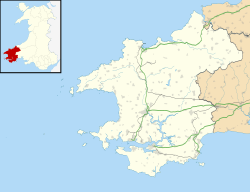| Wisemans Bridge | |
|---|---|
 The seafront at Wisemans Bridge | |
Location within Pembrokeshire | |
| OS grid reference | SN144062 |
| Community |
|
| Principal area | |
| Country | Wales |
| Sovereign state | United Kingdom |
| Police | Dyfed-Powys |
| Fire | Mid and West Wales |
| Ambulance | Welsh |
Wisemans Bridge is a coastal hamlet between Amroth and Saundersfoot in Pembrokeshire, Wales. The small beachfront settlement, which is part of the parish and community of Amroth, [1] was once an important centre for the mineral industry in West Wales. It is now a popular holiday destination within Carmarthen Bay.


